Global Food System and Food Security: Women Empowerment Essay
VerifiedAdded on 2022/12/19
|10
|3075
|28
Essay
AI Summary
This essay examines the critical role of women's empowerment in addressing global food insecurity and hunger. It highlights the disproportionate impact of hunger on women and girls, emphasizing gender inequality as a key factor. The essay explores the barriers women face in agriculture, including limited access to resources, credit, and land ownership, which negatively affect their productivity. It analyzes the Women's Empowerment in Agriculture Index (WEAI) and discusses the importance of education in breaking the cycle of poverty and improving economic outcomes for women. The essay concludes that governmental and international efforts are crucial for promoting women's empowerment through education, access to resources, and equal opportunities, ultimately contributing to improved food security and economic growth in both developed and developing countries. The essay emphasizes the need for addressing the lack of job opportunities and the importance of investing in women's education for the betterment of the global community. This essay is a part of a course on Global Food Systems and Food Security.
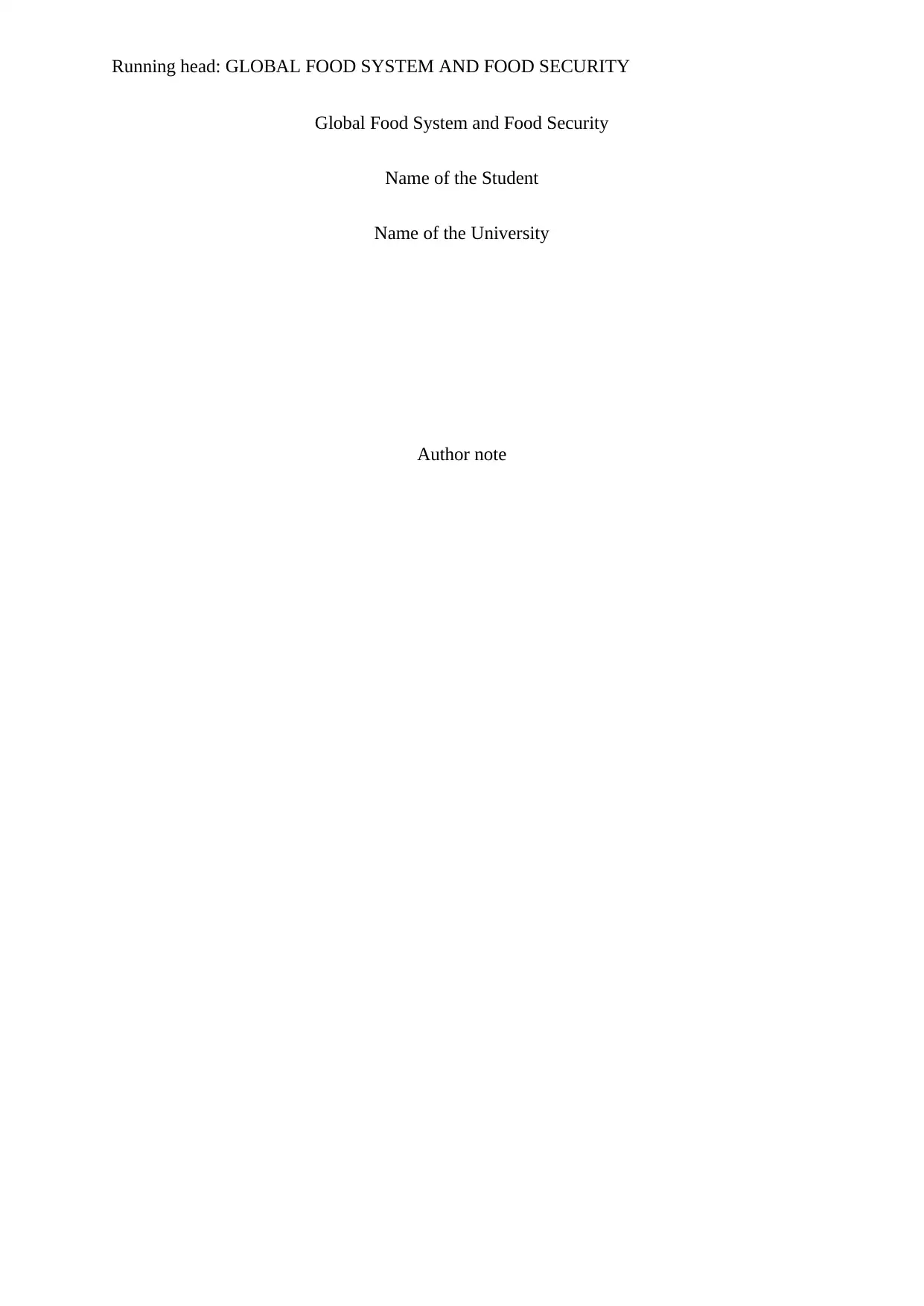
Running head: GLOBAL FOOD SYSTEM AND FOOD SECURITY
Global Food System and Food Security
Name of the Student
Name of the University
Author note
Global Food System and Food Security
Name of the Student
Name of the University
Author note
Paraphrase This Document
Need a fresh take? Get an instant paraphrase of this document with our AI Paraphraser
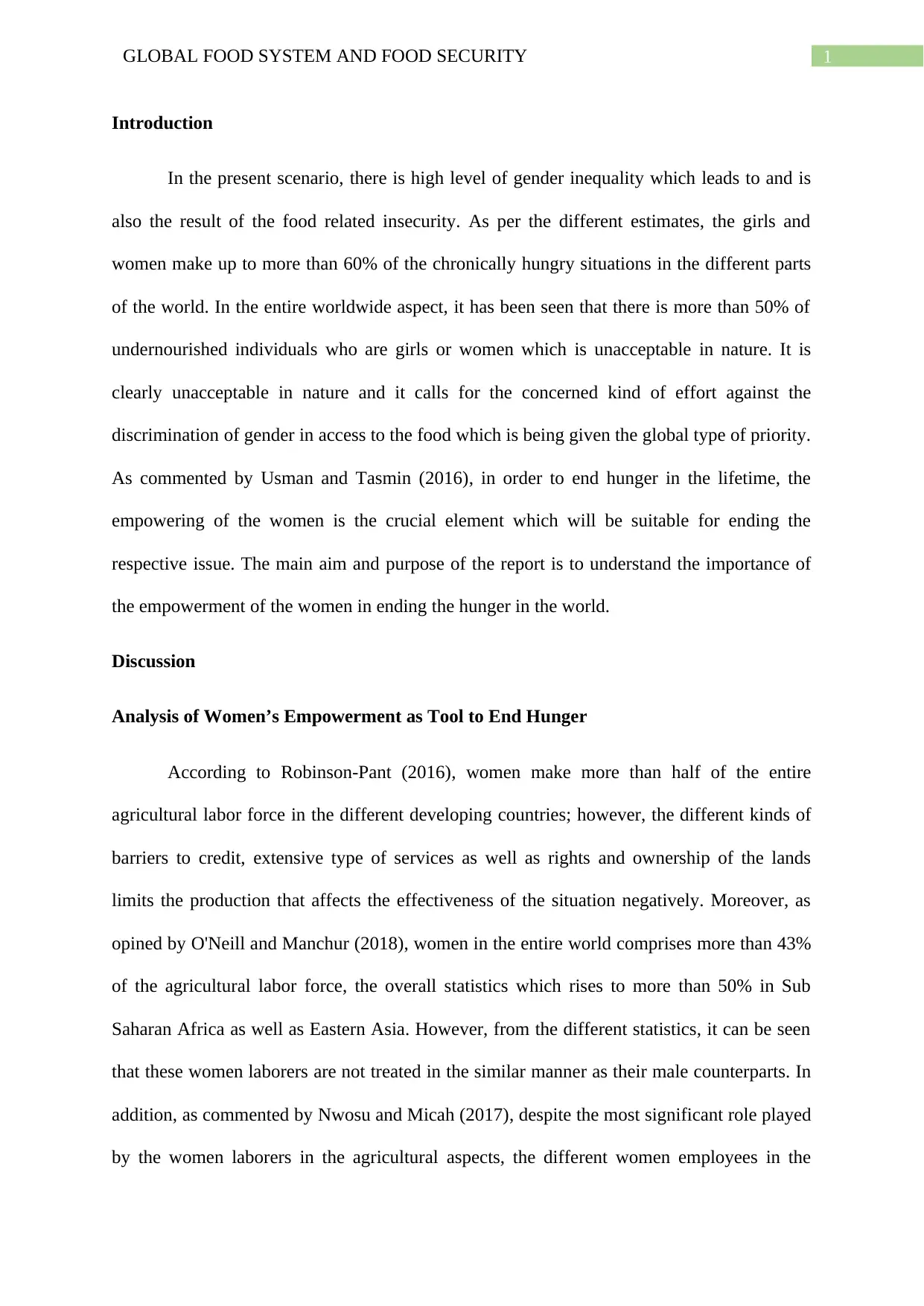
1GLOBAL FOOD SYSTEM AND FOOD SECURITY
Introduction
In the present scenario, there is high level of gender inequality which leads to and is
also the result of the food related insecurity. As per the different estimates, the girls and
women make up to more than 60% of the chronically hungry situations in the different parts
of the world. In the entire worldwide aspect, it has been seen that there is more than 50% of
undernourished individuals who are girls or women which is unacceptable in nature. It is
clearly unacceptable in nature and it calls for the concerned kind of effort against the
discrimination of gender in access to the food which is being given the global type of priority.
As commented by Usman and Tasmin (2016), in order to end hunger in the lifetime, the
empowering of the women is the crucial element which will be suitable for ending the
respective issue. The main aim and purpose of the report is to understand the importance of
the empowerment of the women in ending the hunger in the world.
Discussion
Analysis of Women’s Empowerment as Tool to End Hunger
According to Robinson-Pant (2016), women make more than half of the entire
agricultural labor force in the different developing countries; however, the different kinds of
barriers to credit, extensive type of services as well as rights and ownership of the lands
limits the production that affects the effectiveness of the situation negatively. Moreover, as
opined by O'Neill and Manchur (2018), women in the entire world comprises more than 43%
of the agricultural labor force, the overall statistics which rises to more than 50% in Sub
Saharan Africa as well as Eastern Asia. However, from the different statistics, it can be seen
that these women laborers are not treated in the similar manner as their male counterparts. In
addition, as commented by Nwosu and Micah (2017), despite the most significant role played
by the women laborers in the agricultural aspects, the different women employees in the
Introduction
In the present scenario, there is high level of gender inequality which leads to and is
also the result of the food related insecurity. As per the different estimates, the girls and
women make up to more than 60% of the chronically hungry situations in the different parts
of the world. In the entire worldwide aspect, it has been seen that there is more than 50% of
undernourished individuals who are girls or women which is unacceptable in nature. It is
clearly unacceptable in nature and it calls for the concerned kind of effort against the
discrimination of gender in access to the food which is being given the global type of priority.
As commented by Usman and Tasmin (2016), in order to end hunger in the lifetime, the
empowering of the women is the crucial element which will be suitable for ending the
respective issue. The main aim and purpose of the report is to understand the importance of
the empowerment of the women in ending the hunger in the world.
Discussion
Analysis of Women’s Empowerment as Tool to End Hunger
According to Robinson-Pant (2016), women make more than half of the entire
agricultural labor force in the different developing countries; however, the different kinds of
barriers to credit, extensive type of services as well as rights and ownership of the lands
limits the production that affects the effectiveness of the situation negatively. Moreover, as
opined by O'Neill and Manchur (2018), women in the entire world comprises more than 43%
of the agricultural labor force, the overall statistics which rises to more than 50% in Sub
Saharan Africa as well as Eastern Asia. However, from the different statistics, it can be seen
that these women laborers are not treated in the similar manner as their male counterparts. In
addition, as commented by Nwosu and Micah (2017), despite the most significant role played
by the women laborers in the agricultural aspects, the different women employees in the

2GLOBAL FOOD SYSTEM AND FOOD SECURITY
developing countries face extreme level of poverty, less level of education as well as lower
rate of literacy in comparison to the men.
As commented by Nhamo, Muchuru and Nhamo (2018), in both developing and
developed countries, the different social norms are the ones which creates obligation on
women to be more responsible for maintaining the family farm. Additionally, the women
farmers need to tend crops, they are even expected to cook as well as take care of the entire
family. In order to maintain both sides which includes paid productive type of responsibilities
as well as domestic responsibilities which are unpaid, they face time constraints and it affects
their effectiveness negatively.
Moreover, as opined by Montagnini and Metzel (2017), from the different kinds of
studies, it can be seen that the main difference in the crop yields among men and women
exist, not because that the women farmers are less skilled in farming, however the main
problem is that women have less access to the different resources which includes fertilizers,
equipment along with improved seeds. Furthermore, the land related ownership is the other
aspect wherein there is high level of discrepancy in the ownership of land between women as
well as men in developing regions.
In addition, as commented by Mofya-Mukuka and Kabisa (2018), despite the large
number of the female farmers present in the entire economy, however they do not receive
such level of support from the national as well as international development companies
than the men will be able to achieve. According to Malapit, Sproule and Kovarik (2016), in
many places, it can be seen that the number of women farmers who have access to credit is
less than men which amounts to 5-10% and without proper access to the credit, the women
farmers cannot buy the different resources which are essential for farming such as tools,
fertilizers or seeds or investing in the irrigation process or the improvement of the land.
developing countries face extreme level of poverty, less level of education as well as lower
rate of literacy in comparison to the men.
As commented by Nhamo, Muchuru and Nhamo (2018), in both developing and
developed countries, the different social norms are the ones which creates obligation on
women to be more responsible for maintaining the family farm. Additionally, the women
farmers need to tend crops, they are even expected to cook as well as take care of the entire
family. In order to maintain both sides which includes paid productive type of responsibilities
as well as domestic responsibilities which are unpaid, they face time constraints and it affects
their effectiveness negatively.
Moreover, as opined by Montagnini and Metzel (2017), from the different kinds of
studies, it can be seen that the main difference in the crop yields among men and women
exist, not because that the women farmers are less skilled in farming, however the main
problem is that women have less access to the different resources which includes fertilizers,
equipment along with improved seeds. Furthermore, the land related ownership is the other
aspect wherein there is high level of discrepancy in the ownership of land between women as
well as men in developing regions.
In addition, as commented by Mofya-Mukuka and Kabisa (2018), despite the large
number of the female farmers present in the entire economy, however they do not receive
such level of support from the national as well as international development companies
than the men will be able to achieve. According to Malapit, Sproule and Kovarik (2016), in
many places, it can be seen that the number of women farmers who have access to credit is
less than men which amounts to 5-10% and without proper access to the credit, the women
farmers cannot buy the different resources which are essential for farming such as tools,
fertilizers or seeds or investing in the irrigation process or the improvement of the land.
⊘ This is a preview!⊘
Do you want full access?
Subscribe today to unlock all pages.

Trusted by 1+ million students worldwide
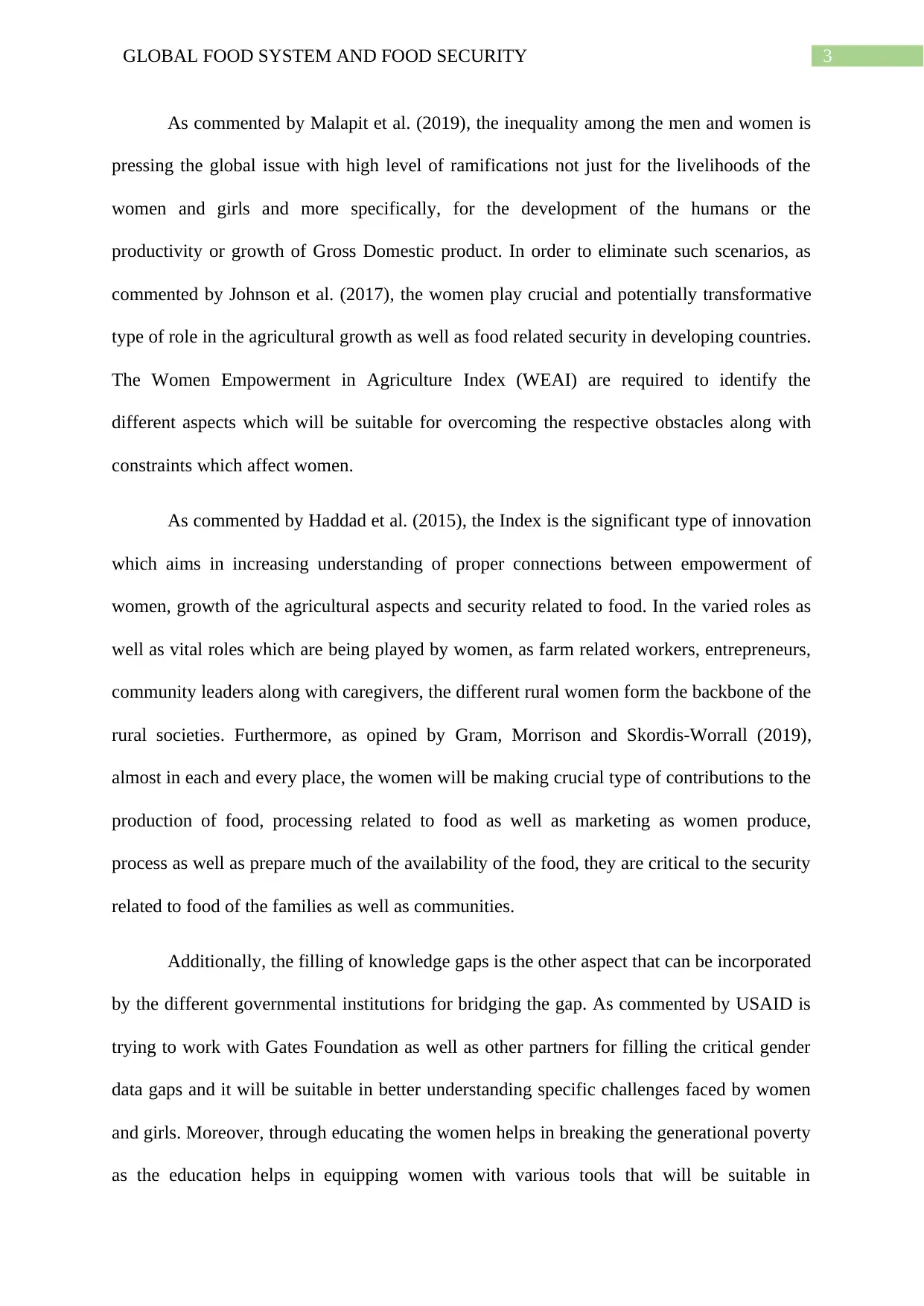
3GLOBAL FOOD SYSTEM AND FOOD SECURITY
As commented by Malapit et al. (2019), the inequality among the men and women is
pressing the global issue with high level of ramifications not just for the livelihoods of the
women and girls and more specifically, for the development of the humans or the
productivity or growth of Gross Domestic product. In order to eliminate such scenarios, as
commented by Johnson et al. (2017), the women play crucial and potentially transformative
type of role in the agricultural growth as well as food related security in developing countries.
The Women Empowerment in Agriculture Index (WEAI) are required to identify the
different aspects which will be suitable for overcoming the respective obstacles along with
constraints which affect women.
As commented by Haddad et al. (2015), the Index is the significant type of innovation
which aims in increasing understanding of proper connections between empowerment of
women, growth of the agricultural aspects and security related to food. In the varied roles as
well as vital roles which are being played by women, as farm related workers, entrepreneurs,
community leaders along with caregivers, the different rural women form the backbone of the
rural societies. Furthermore, as opined by Gram, Morrison and Skordis-Worrall (2019),
almost in each and every place, the women will be making crucial type of contributions to the
production of food, processing related to food as well as marketing as women produce,
process as well as prepare much of the availability of the food, they are critical to the security
related to food of the families as well as communities.
Additionally, the filling of knowledge gaps is the other aspect that can be incorporated
by the different governmental institutions for bridging the gap. As commented by USAID is
trying to work with Gates Foundation as well as other partners for filling the critical gender
data gaps and it will be suitable in better understanding specific challenges faced by women
and girls. Moreover, through educating the women helps in breaking the generational poverty
as the education helps in equipping women with various tools that will be suitable in
As commented by Malapit et al. (2019), the inequality among the men and women is
pressing the global issue with high level of ramifications not just for the livelihoods of the
women and girls and more specifically, for the development of the humans or the
productivity or growth of Gross Domestic product. In order to eliminate such scenarios, as
commented by Johnson et al. (2017), the women play crucial and potentially transformative
type of role in the agricultural growth as well as food related security in developing countries.
The Women Empowerment in Agriculture Index (WEAI) are required to identify the
different aspects which will be suitable for overcoming the respective obstacles along with
constraints which affect women.
As commented by Haddad et al. (2015), the Index is the significant type of innovation
which aims in increasing understanding of proper connections between empowerment of
women, growth of the agricultural aspects and security related to food. In the varied roles as
well as vital roles which are being played by women, as farm related workers, entrepreneurs,
community leaders along with caregivers, the different rural women form the backbone of the
rural societies. Furthermore, as opined by Gram, Morrison and Skordis-Worrall (2019),
almost in each and every place, the women will be making crucial type of contributions to the
production of food, processing related to food as well as marketing as women produce,
process as well as prepare much of the availability of the food, they are critical to the security
related to food of the families as well as communities.
Additionally, the filling of knowledge gaps is the other aspect that can be incorporated
by the different governmental institutions for bridging the gap. As commented by USAID is
trying to work with Gates Foundation as well as other partners for filling the critical gender
data gaps and it will be suitable in better understanding specific challenges faced by women
and girls. Moreover, through educating the women helps in breaking the generational poverty
as the education helps in equipping women with various tools that will be suitable in
Paraphrase This Document
Need a fresh take? Get an instant paraphrase of this document with our AI Paraphraser

4GLOBAL FOOD SYSTEM AND FOOD SECURITY
developing proper aspirations and it will be helpful for them in generating capacity to be
more successful in their career. Moreover, as opined by Galiè et al. (2019), the education
helps in narrowing the gap related to pay between women and men and increases likelihood
of the women finding work as it is suitable for providing the girls with different opportunities
and choices.
Besides, as commented by Canavan et al. (2016), the women and girls play vital role
in ending the global poverty and it is the most instrumental for the well-being of individuals
and society as the whole, therefore striving of the equality of the men and women is essential.
According to Brown, Platt and Beattie (2015), the educating the girls and women creates the
healthier families, as providing the girls assists in increasing the health of the family and it all
starts with mothers. When the mothers are able to complete the primary education, the
maternal deaths would decrease by two thirds and healthy kind of mothers can have the
chance to nurture healthy babies which will be suitable for improving the growth of the
country suitably. If each and every woman finished the primary along with secondary
education, the deaths of the children would be cut in half and more than twelve million
children will be saved from stunting which is caused due to malnutrition.
As opined by Bangert et al. (2017), the empowering of the women for engaging in the
different communities will be suitable for understanding the best techniques of farming which
can be used for teaching regarding the good sanitary habits as well as health related aspects
and it will be suitable for the individuals to understand the importance of education suitably.
It will be beneficial in preventing the malnutrition among the individuals specially the
women in different developing countries. As opined by Brown, Platt and Beattie (2015), there
can be increase in the amount of wages as the different educated people are always paid more
than the others who are uneducated. The education provided to the different women will be
developing proper aspirations and it will be helpful for them in generating capacity to be
more successful in their career. Moreover, as opined by Galiè et al. (2019), the education
helps in narrowing the gap related to pay between women and men and increases likelihood
of the women finding work as it is suitable for providing the girls with different opportunities
and choices.
Besides, as commented by Canavan et al. (2016), the women and girls play vital role
in ending the global poverty and it is the most instrumental for the well-being of individuals
and society as the whole, therefore striving of the equality of the men and women is essential.
According to Brown, Platt and Beattie (2015), the educating the girls and women creates the
healthier families, as providing the girls assists in increasing the health of the family and it all
starts with mothers. When the mothers are able to complete the primary education, the
maternal deaths would decrease by two thirds and healthy kind of mothers can have the
chance to nurture healthy babies which will be suitable for improving the growth of the
country suitably. If each and every woman finished the primary along with secondary
education, the deaths of the children would be cut in half and more than twelve million
children will be saved from stunting which is caused due to malnutrition.
As opined by Bangert et al. (2017), the empowering of the women for engaging in the
different communities will be suitable for understanding the best techniques of farming which
can be used for teaching regarding the good sanitary habits as well as health related aspects
and it will be suitable for the individuals to understand the importance of education suitably.
It will be beneficial in preventing the malnutrition among the individuals specially the
women in different developing countries. As opined by Brown, Platt and Beattie (2015), there
can be increase in the amount of wages as the different educated people are always paid more
than the others who are uneducated. The education provided to the different women will be
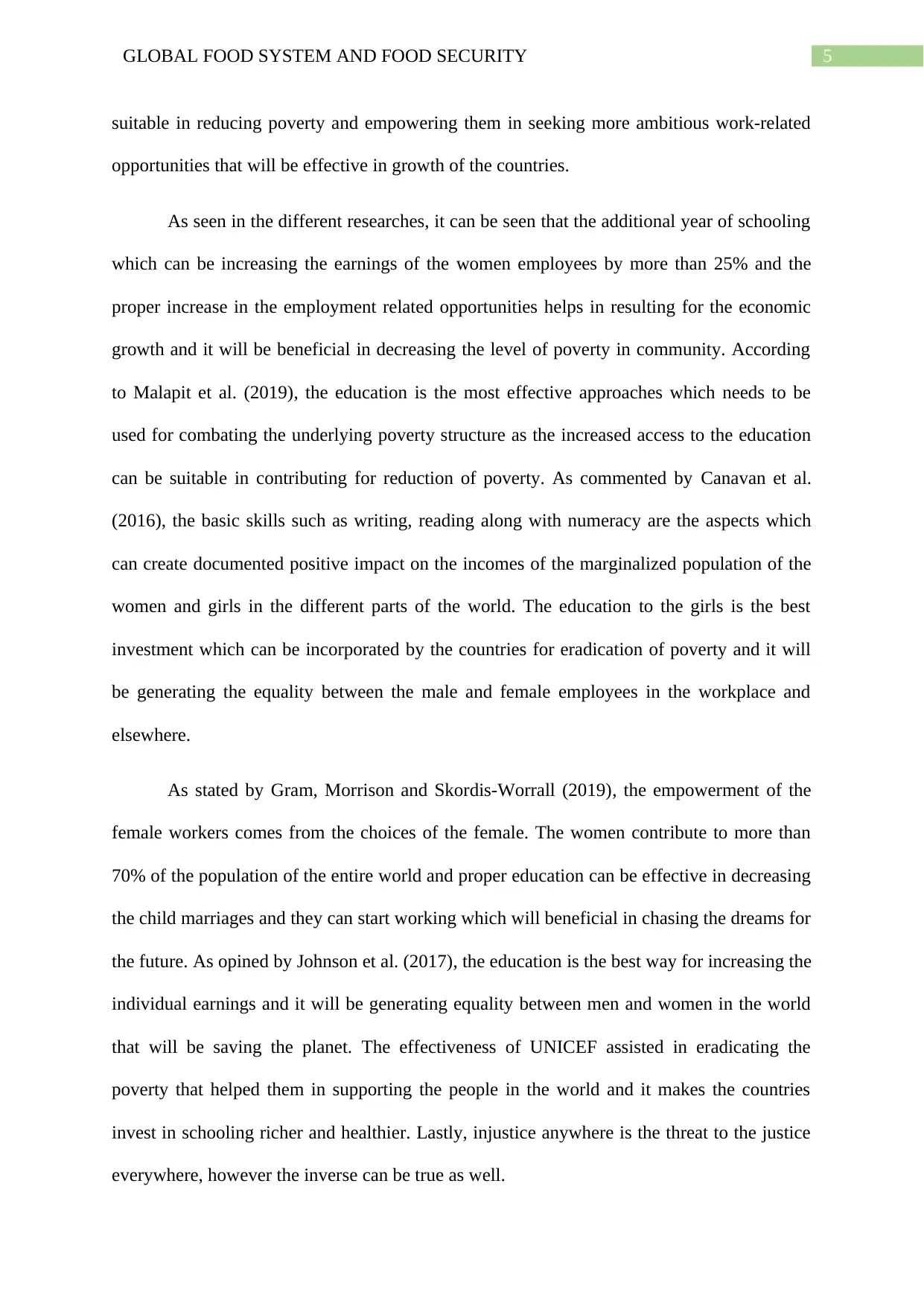
5GLOBAL FOOD SYSTEM AND FOOD SECURITY
suitable in reducing poverty and empowering them in seeking more ambitious work-related
opportunities that will be effective in growth of the countries.
As seen in the different researches, it can be seen that the additional year of schooling
which can be increasing the earnings of the women employees by more than 25% and the
proper increase in the employment related opportunities helps in resulting for the economic
growth and it will be beneficial in decreasing the level of poverty in community. According
to Malapit et al. (2019), the education is the most effective approaches which needs to be
used for combating the underlying poverty structure as the increased access to the education
can be suitable in contributing for reduction of poverty. As commented by Canavan et al.
(2016), the basic skills such as writing, reading along with numeracy are the aspects which
can create documented positive impact on the incomes of the marginalized population of the
women and girls in the different parts of the world. The education to the girls is the best
investment which can be incorporated by the countries for eradication of poverty and it will
be generating the equality between the male and female employees in the workplace and
elsewhere.
As stated by Gram, Morrison and Skordis-Worrall (2019), the empowerment of the
female workers comes from the choices of the female. The women contribute to more than
70% of the population of the entire world and proper education can be effective in decreasing
the child marriages and they can start working which will beneficial in chasing the dreams for
the future. As opined by Johnson et al. (2017), the education is the best way for increasing the
individual earnings and it will be generating equality between men and women in the world
that will be saving the planet. The effectiveness of UNICEF assisted in eradicating the
poverty that helped them in supporting the people in the world and it makes the countries
invest in schooling richer and healthier. Lastly, injustice anywhere is the threat to the justice
everywhere, however the inverse can be true as well.
suitable in reducing poverty and empowering them in seeking more ambitious work-related
opportunities that will be effective in growth of the countries.
As seen in the different researches, it can be seen that the additional year of schooling
which can be increasing the earnings of the women employees by more than 25% and the
proper increase in the employment related opportunities helps in resulting for the economic
growth and it will be beneficial in decreasing the level of poverty in community. According
to Malapit et al. (2019), the education is the most effective approaches which needs to be
used for combating the underlying poverty structure as the increased access to the education
can be suitable in contributing for reduction of poverty. As commented by Canavan et al.
(2016), the basic skills such as writing, reading along with numeracy are the aspects which
can create documented positive impact on the incomes of the marginalized population of the
women and girls in the different parts of the world. The education to the girls is the best
investment which can be incorporated by the countries for eradication of poverty and it will
be generating the equality between the male and female employees in the workplace and
elsewhere.
As stated by Gram, Morrison and Skordis-Worrall (2019), the empowerment of the
female workers comes from the choices of the female. The women contribute to more than
70% of the population of the entire world and proper education can be effective in decreasing
the child marriages and they can start working which will beneficial in chasing the dreams for
the future. As opined by Johnson et al. (2017), the education is the best way for increasing the
individual earnings and it will be generating equality between men and women in the world
that will be saving the planet. The effectiveness of UNICEF assisted in eradicating the
poverty that helped them in supporting the people in the world and it makes the countries
invest in schooling richer and healthier. Lastly, injustice anywhere is the threat to the justice
everywhere, however the inverse can be true as well.
⊘ This is a preview!⊘
Do you want full access?
Subscribe today to unlock all pages.

Trusted by 1+ million students worldwide
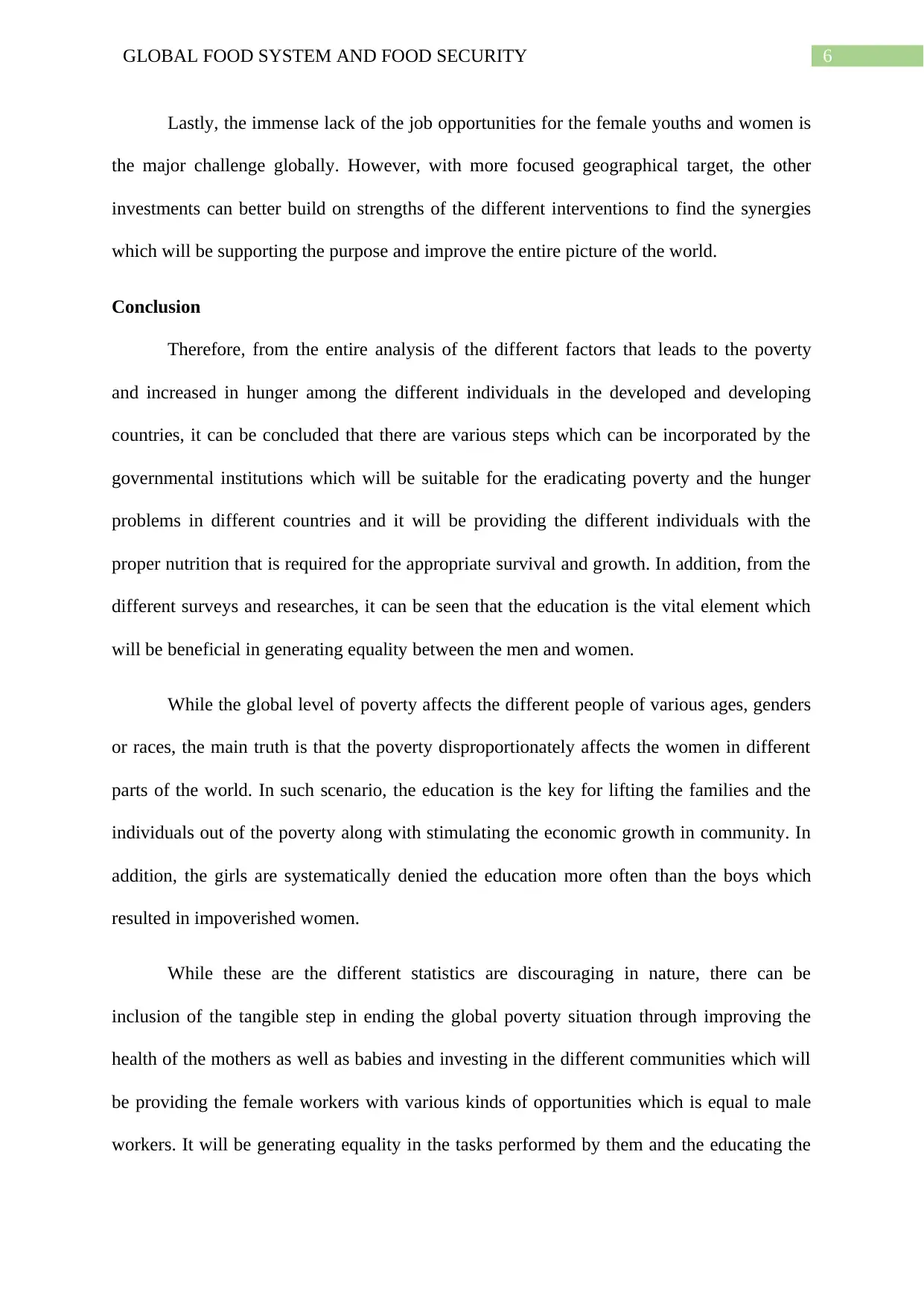
6GLOBAL FOOD SYSTEM AND FOOD SECURITY
Lastly, the immense lack of the job opportunities for the female youths and women is
the major challenge globally. However, with more focused geographical target, the other
investments can better build on strengths of the different interventions to find the synergies
which will be supporting the purpose and improve the entire picture of the world.
Conclusion
Therefore, from the entire analysis of the different factors that leads to the poverty
and increased in hunger among the different individuals in the developed and developing
countries, it can be concluded that there are various steps which can be incorporated by the
governmental institutions which will be suitable for the eradicating poverty and the hunger
problems in different countries and it will be providing the different individuals with the
proper nutrition that is required for the appropriate survival and growth. In addition, from the
different surveys and researches, it can be seen that the education is the vital element which
will be beneficial in generating equality between the men and women.
While the global level of poverty affects the different people of various ages, genders
or races, the main truth is that the poverty disproportionately affects the women in different
parts of the world. In such scenario, the education is the key for lifting the families and the
individuals out of the poverty along with stimulating the economic growth in community. In
addition, the girls are systematically denied the education more often than the boys which
resulted in impoverished women.
While these are the different statistics are discouraging in nature, there can be
inclusion of the tangible step in ending the global poverty situation through improving the
health of the mothers as well as babies and investing in the different communities which will
be providing the female workers with various kinds of opportunities which is equal to male
workers. It will be generating equality in the tasks performed by them and the educating the
Lastly, the immense lack of the job opportunities for the female youths and women is
the major challenge globally. However, with more focused geographical target, the other
investments can better build on strengths of the different interventions to find the synergies
which will be supporting the purpose and improve the entire picture of the world.
Conclusion
Therefore, from the entire analysis of the different factors that leads to the poverty
and increased in hunger among the different individuals in the developed and developing
countries, it can be concluded that there are various steps which can be incorporated by the
governmental institutions which will be suitable for the eradicating poverty and the hunger
problems in different countries and it will be providing the different individuals with the
proper nutrition that is required for the appropriate survival and growth. In addition, from the
different surveys and researches, it can be seen that the education is the vital element which
will be beneficial in generating equality between the men and women.
While the global level of poverty affects the different people of various ages, genders
or races, the main truth is that the poverty disproportionately affects the women in different
parts of the world. In such scenario, the education is the key for lifting the families and the
individuals out of the poverty along with stimulating the economic growth in community. In
addition, the girls are systematically denied the education more often than the boys which
resulted in impoverished women.
While these are the different statistics are discouraging in nature, there can be
inclusion of the tangible step in ending the global poverty situation through improving the
health of the mothers as well as babies and investing in the different communities which will
be providing the female workers with various kinds of opportunities which is equal to male
workers. It will be generating equality in the tasks performed by them and the educating the
Paraphrase This Document
Need a fresh take? Get an instant paraphrase of this document with our AI Paraphraser
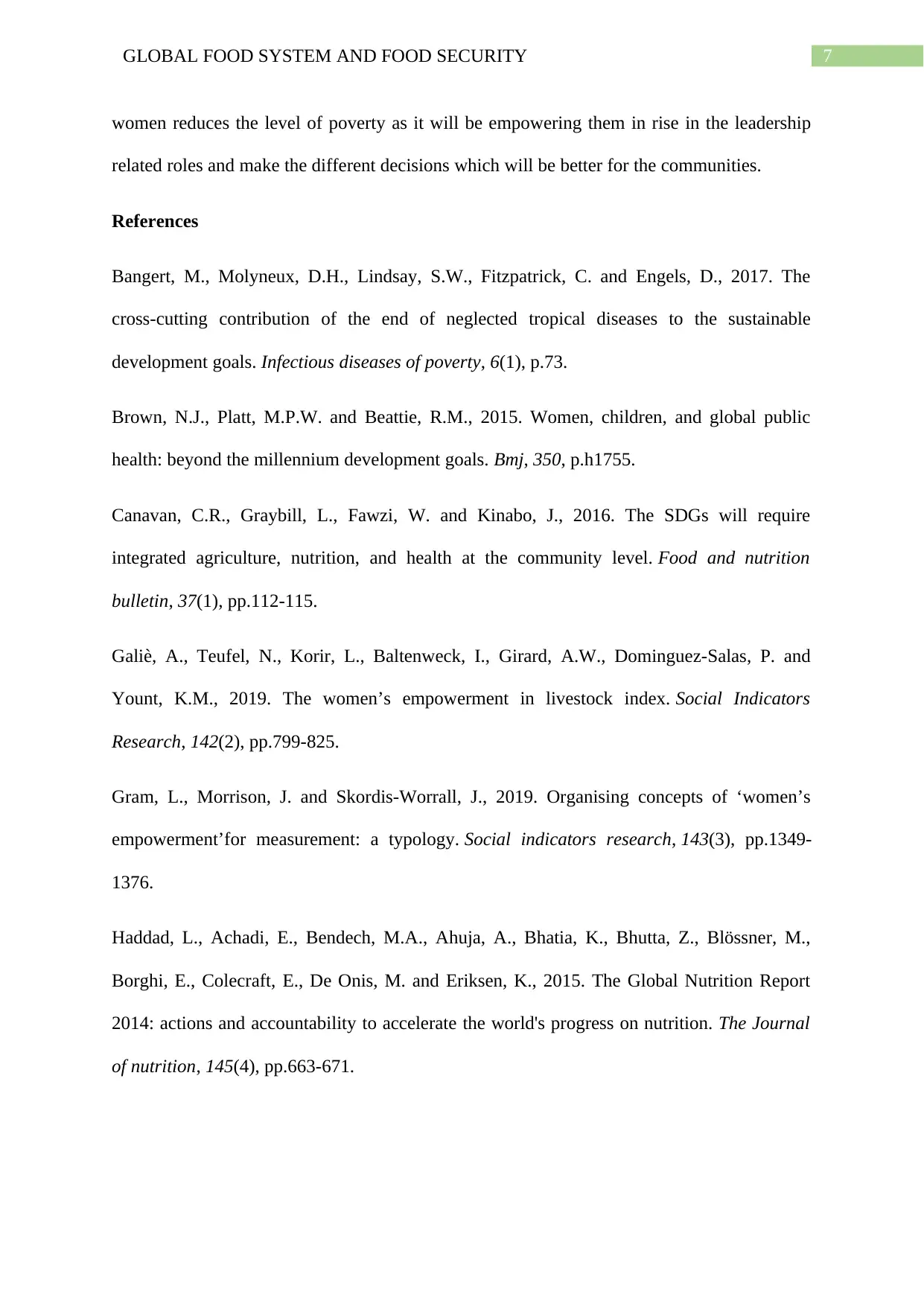
7GLOBAL FOOD SYSTEM AND FOOD SECURITY
women reduces the level of poverty as it will be empowering them in rise in the leadership
related roles and make the different decisions which will be better for the communities.
References
Bangert, M., Molyneux, D.H., Lindsay, S.W., Fitzpatrick, C. and Engels, D., 2017. The
cross-cutting contribution of the end of neglected tropical diseases to the sustainable
development goals. Infectious diseases of poverty, 6(1), p.73.
Brown, N.J., Platt, M.P.W. and Beattie, R.M., 2015. Women, children, and global public
health: beyond the millennium development goals. Bmj, 350, p.h1755.
Canavan, C.R., Graybill, L., Fawzi, W. and Kinabo, J., 2016. The SDGs will require
integrated agriculture, nutrition, and health at the community level. Food and nutrition
bulletin, 37(1), pp.112-115.
Galiè, A., Teufel, N., Korir, L., Baltenweck, I., Girard, A.W., Dominguez-Salas, P. and
Yount, K.M., 2019. The women’s empowerment in livestock index. Social Indicators
Research, 142(2), pp.799-825.
Gram, L., Morrison, J. and Skordis-Worrall, J., 2019. Organising concepts of ‘women’s
empowerment’for measurement: a typology. Social indicators research, 143(3), pp.1349-
1376.
Haddad, L., Achadi, E., Bendech, M.A., Ahuja, A., Bhatia, K., Bhutta, Z., Blössner, M.,
Borghi, E., Colecraft, E., De Onis, M. and Eriksen, K., 2015. The Global Nutrition Report
2014: actions and accountability to accelerate the world's progress on nutrition. The Journal
of nutrition, 145(4), pp.663-671.
women reduces the level of poverty as it will be empowering them in rise in the leadership
related roles and make the different decisions which will be better for the communities.
References
Bangert, M., Molyneux, D.H., Lindsay, S.W., Fitzpatrick, C. and Engels, D., 2017. The
cross-cutting contribution of the end of neglected tropical diseases to the sustainable
development goals. Infectious diseases of poverty, 6(1), p.73.
Brown, N.J., Platt, M.P.W. and Beattie, R.M., 2015. Women, children, and global public
health: beyond the millennium development goals. Bmj, 350, p.h1755.
Canavan, C.R., Graybill, L., Fawzi, W. and Kinabo, J., 2016. The SDGs will require
integrated agriculture, nutrition, and health at the community level. Food and nutrition
bulletin, 37(1), pp.112-115.
Galiè, A., Teufel, N., Korir, L., Baltenweck, I., Girard, A.W., Dominguez-Salas, P. and
Yount, K.M., 2019. The women’s empowerment in livestock index. Social Indicators
Research, 142(2), pp.799-825.
Gram, L., Morrison, J. and Skordis-Worrall, J., 2019. Organising concepts of ‘women’s
empowerment’for measurement: a typology. Social indicators research, 143(3), pp.1349-
1376.
Haddad, L., Achadi, E., Bendech, M.A., Ahuja, A., Bhatia, K., Bhutta, Z., Blössner, M.,
Borghi, E., Colecraft, E., De Onis, M. and Eriksen, K., 2015. The Global Nutrition Report
2014: actions and accountability to accelerate the world's progress on nutrition. The Journal
of nutrition, 145(4), pp.663-671.
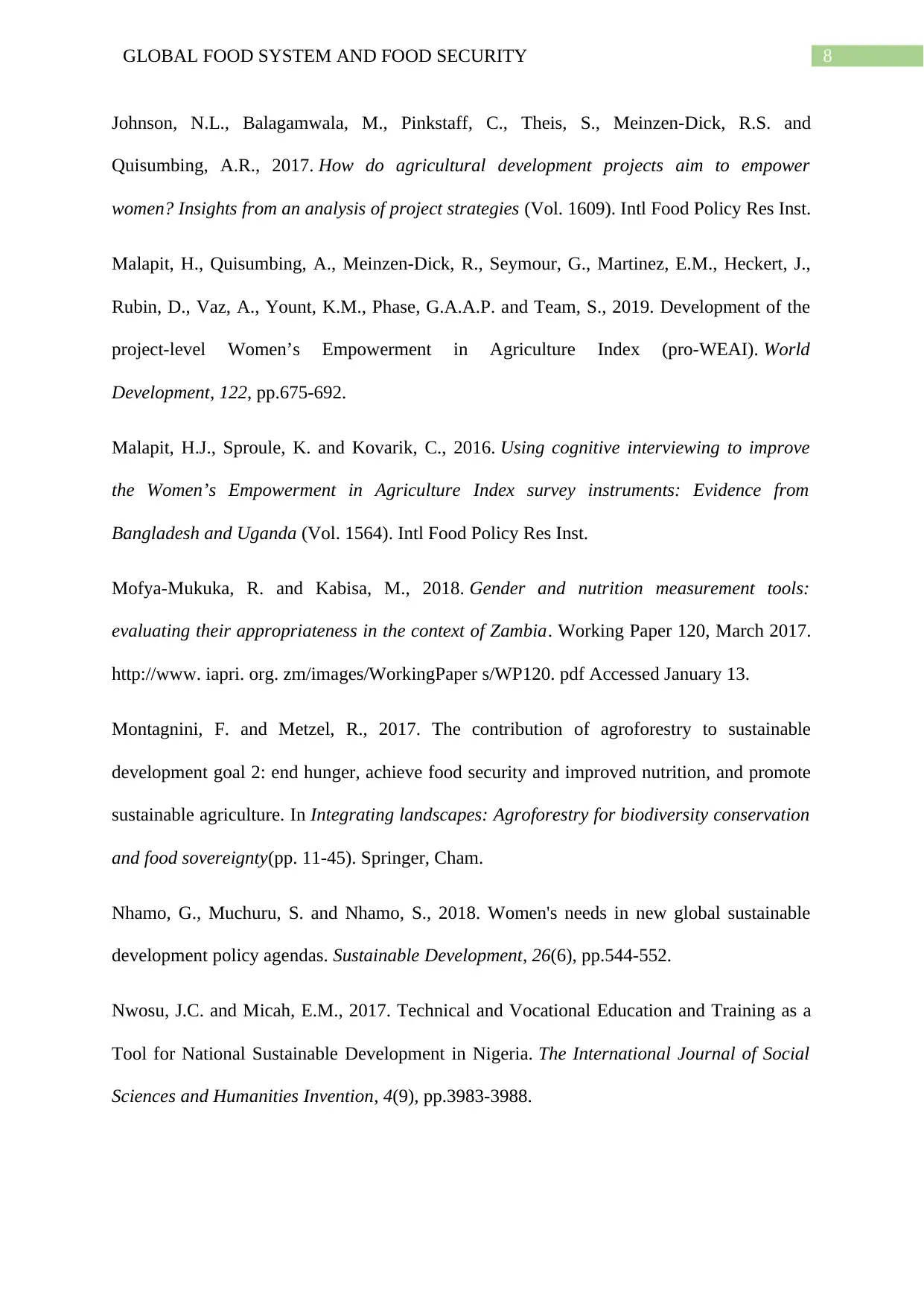
8GLOBAL FOOD SYSTEM AND FOOD SECURITY
Johnson, N.L., Balagamwala, M., Pinkstaff, C., Theis, S., Meinzen-Dick, R.S. and
Quisumbing, A.R., 2017. How do agricultural development projects aim to empower
women? Insights from an analysis of project strategies (Vol. 1609). Intl Food Policy Res Inst.
Malapit, H., Quisumbing, A., Meinzen-Dick, R., Seymour, G., Martinez, E.M., Heckert, J.,
Rubin, D., Vaz, A., Yount, K.M., Phase, G.A.A.P. and Team, S., 2019. Development of the
project-level Women’s Empowerment in Agriculture Index (pro-WEAI). World
Development, 122, pp.675-692.
Malapit, H.J., Sproule, K. and Kovarik, C., 2016. Using cognitive interviewing to improve
the Women’s Empowerment in Agriculture Index survey instruments: Evidence from
Bangladesh and Uganda (Vol. 1564). Intl Food Policy Res Inst.
Mofya-Mukuka, R. and Kabisa, M., 2018. Gender and nutrition measurement tools:
evaluating their appropriateness in the context of Zambia. Working Paper 120, March 2017.
http://www. iapri. org. zm/images/WorkingPaper s/WP120. pdf Accessed January 13.
Montagnini, F. and Metzel, R., 2017. The contribution of agroforestry to sustainable
development goal 2: end hunger, achieve food security and improved nutrition, and promote
sustainable agriculture. In Integrating landscapes: Agroforestry for biodiversity conservation
and food sovereignty(pp. 11-45). Springer, Cham.
Nhamo, G., Muchuru, S. and Nhamo, S., 2018. Women's needs in new global sustainable
development policy agendas. Sustainable Development, 26(6), pp.544-552.
Nwosu, J.C. and Micah, E.M., 2017. Technical and Vocational Education and Training as a
Tool for National Sustainable Development in Nigeria. The International Journal of Social
Sciences and Humanities Invention, 4(9), pp.3983-3988.
Johnson, N.L., Balagamwala, M., Pinkstaff, C., Theis, S., Meinzen-Dick, R.S. and
Quisumbing, A.R., 2017. How do agricultural development projects aim to empower
women? Insights from an analysis of project strategies (Vol. 1609). Intl Food Policy Res Inst.
Malapit, H., Quisumbing, A., Meinzen-Dick, R., Seymour, G., Martinez, E.M., Heckert, J.,
Rubin, D., Vaz, A., Yount, K.M., Phase, G.A.A.P. and Team, S., 2019. Development of the
project-level Women’s Empowerment in Agriculture Index (pro-WEAI). World
Development, 122, pp.675-692.
Malapit, H.J., Sproule, K. and Kovarik, C., 2016. Using cognitive interviewing to improve
the Women’s Empowerment in Agriculture Index survey instruments: Evidence from
Bangladesh and Uganda (Vol. 1564). Intl Food Policy Res Inst.
Mofya-Mukuka, R. and Kabisa, M., 2018. Gender and nutrition measurement tools:
evaluating their appropriateness in the context of Zambia. Working Paper 120, March 2017.
http://www. iapri. org. zm/images/WorkingPaper s/WP120. pdf Accessed January 13.
Montagnini, F. and Metzel, R., 2017. The contribution of agroforestry to sustainable
development goal 2: end hunger, achieve food security and improved nutrition, and promote
sustainable agriculture. In Integrating landscapes: Agroforestry for biodiversity conservation
and food sovereignty(pp. 11-45). Springer, Cham.
Nhamo, G., Muchuru, S. and Nhamo, S., 2018. Women's needs in new global sustainable
development policy agendas. Sustainable Development, 26(6), pp.544-552.
Nwosu, J.C. and Micah, E.M., 2017. Technical and Vocational Education and Training as a
Tool for National Sustainable Development in Nigeria. The International Journal of Social
Sciences and Humanities Invention, 4(9), pp.3983-3988.
⊘ This is a preview!⊘
Do you want full access?
Subscribe today to unlock all pages.

Trusted by 1+ million students worldwide
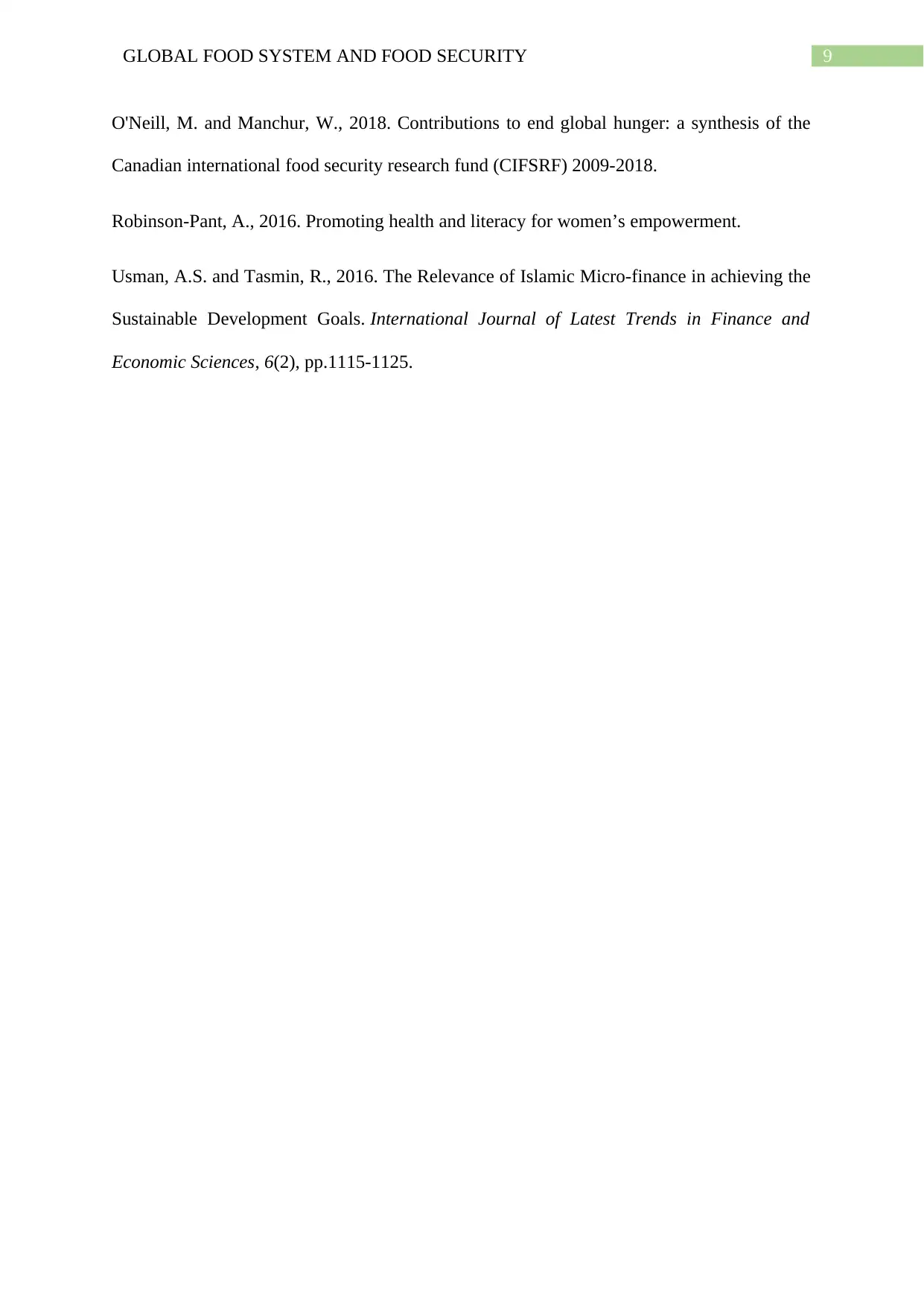
9GLOBAL FOOD SYSTEM AND FOOD SECURITY
O'Neill, M. and Manchur, W., 2018. Contributions to end global hunger: a synthesis of the
Canadian international food security research fund (CIFSRF) 2009-2018.
Robinson-Pant, A., 2016. Promoting health and literacy for women’s empowerment.
Usman, A.S. and Tasmin, R., 2016. The Relevance of Islamic Micro-finance in achieving the
Sustainable Development Goals. International Journal of Latest Trends in Finance and
Economic Sciences, 6(2), pp.1115-1125.
O'Neill, M. and Manchur, W., 2018. Contributions to end global hunger: a synthesis of the
Canadian international food security research fund (CIFSRF) 2009-2018.
Robinson-Pant, A., 2016. Promoting health and literacy for women’s empowerment.
Usman, A.S. and Tasmin, R., 2016. The Relevance of Islamic Micro-finance in achieving the
Sustainable Development Goals. International Journal of Latest Trends in Finance and
Economic Sciences, 6(2), pp.1115-1125.
1 out of 10
Related Documents
Your All-in-One AI-Powered Toolkit for Academic Success.
+13062052269
info@desklib.com
Available 24*7 on WhatsApp / Email
![[object Object]](/_next/static/media/star-bottom.7253800d.svg)
Unlock your academic potential
Copyright © 2020–2025 A2Z Services. All Rights Reserved. Developed and managed by ZUCOL.





